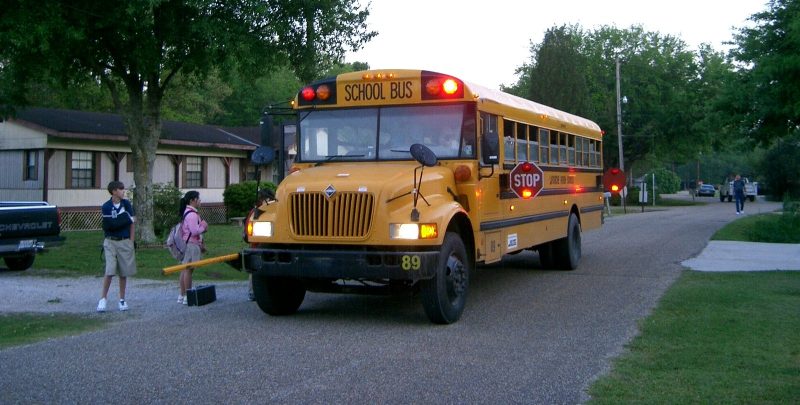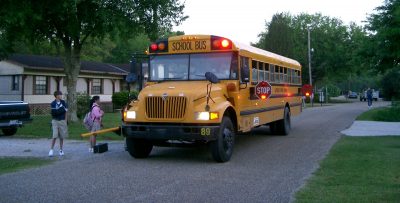Table of Contents
Best Method for getting to school
The iconic yellow school bus has existed in America for nearly 80 years as the predominant choice for getting children to school. Despite their fixed place in the American volksgeist, parents, educators, and even children themselves may wonder— are school buses the best way to transport millions of children? Are they the safest option for so many kids? Can these large vehicles be energy efficient, or even environmentally friendly? Many misconceptions exist around yellow school buses, especially around the issue of seat belts. I want to address these misconceptions, head on, with solid research, so you can discern the best way to keep your children safe.
The Facts about School Buses
It may surprise you to learn that school buses are by far the safest way for children to travel to and from school. The US Department of Transportation reports that children and teens are 50 times less likely to get in a fatal accident riding the bus than with a peer driver. It is even more surprising that children are far safer taking the school bus than being driven by a parent. The breakdown of student fatalities, during traveling hours, from 2001–2008 is as follows:
- 58% of students killed are traveling with a teen driver
- 23% Traveling with an adult
- 18% Other causes
- 1% Traveling by school bus
These numbers become even more jaw-dropping when you consider that 53% of K–12 children in the US travel by school bus.
Safety Features of School Buses
School buses each contain the following ways to ensure safety for the bus drivers, young students, and fellow drivers. Each come as standard features with the classic yellow school bus.
- Cross-view Mirrors
- Reinforced Side Foundations
- Bright Colors
- Extending Stop Sign
- Blinking and Flashing Lights
No Seat Belts?
Some may have fears about the lack of seat belts in standard-issue school buses (shorter buses, specializing in special-needs students or preschool, are required to utilize seat belts). The US Dept. of Transportation provided a thorough explanation behind the absence of seat belts in school buses. School buses perform extremely well when absorbing collision-type contact and by using a concept called “compartmentalization.”
Large school buses are heavier and distribute crash forces differently than do passenger cars and light trucks. Because of these differences, the crash forces experienced by occupants of buses are much less than that experienced by occupants of passenger cars, light trucks or vans….Through compartmentalization, occupant crash protection is provided by a protective envelope consisting of strong, closely-spaced seats that have energy-absorbing seat backs. (NHTSA 2002)
The National Transportation Safety Board (NTSB) has found through numerous reports that increased spending on seat belts for school buses would have “little” to “no benefit.” In some cases, lap seat belts even increased risks for abdominal injuries. Instead, National and State Public Transportation organizations have found it much more beneficial (from a safety as well as a cost efficiency measure) to use funds on bus safety programs and new bus devices that could save lives in the future.
School Bus Personnel
School Bus Drivers and Staff maintain a high level of safety. Drivers are specifically trained in student behavior management, including the loading and unloading of children regularly. Frequent driving record checks and drug/alcohol tests are also performed to ensure a standard of excellence. Drivers are also trained in emergency medical procedures for children to prepare staff for any threatening situation.
Expense/Environmental Benefits of School Buses
The seeming novelty of yellow school buses allows over 17 million cars to stay off the road. School buses decrease the total amount of traffic, mitigating pollution and easing the financial burden of transportation. School Buses create a total national savings of:
- 2.3 Billion gallons of fuel
- 6 Billion dollars in miscellaneous savings
- 44.6 Billion pounds of CO2
Don Carnahan, president of the National Association for Pupil Transportation, along with others in the industry, stated the following about the public school bus system..
“The yellow school bus provides safe, reliable, energy-efficient transportation that ensures high attendance, which is a lynchpin of higher achievement by students. Everyone who wants kids to succeed [should support the system.]”
Seat Belts and Children
Can children become accustomed to not wearing seat belts, as they do on public school buses, and apply the same logic to other automobiles? A report in 2009 by the National Highway Traffic Safety Administration states there is no evidence to support the assumption that children will wear seat belts less in cars because they don’t on the bus.
For children, knowledge is usually only applied in the context in which it was learned. The premature development of a child’s brain leads to compartmentalized thinking, allowing for a distinction to be made between buses and cars. They are also less likely to confuse the two situations when given specific feedback from a parent or adult as to proper seat belt usage. Parents remain the largest influence on and indicator of a child’s seat belt wearing.
Promoting Safety around School Buses
Awareness is paramount when we think about increasing school bus safety: parents, children educators, bus drivers, and other motorists are all responsible.
For Motorists
- Pay special attention when backing out of a garage, or backing up at all, that no children are in the vicinity.
- Slow down and pay special attention around school zones, bus-loading zones, and anywhere children may assemble.
- Learn what the Flashing Light Signals mean: Yellow Lights: The bus will stop momentarily. Motorists should prepare to stop and watch for children as they often dart out of the bus into the street. Red Lights: The bus is stopped, and the extended stop-sign-arm is visible. The motorist must come to a complete stop, and wait until the sign is removed before proceeding.
The biggest problem surrounding school buses (and a leader in pedestrian/student fatalities) is the failure to stop at bus’ “stop sign arms.” When the bus is in a loading zone and the stop sign arm is extended, it is a crucial safety situation. A 2000 Report on illegal passing stated:
In 1996, the Illinois Department of Transportation’s Division of Traffic Safety conducted a probability-based sample survey of 250 school buses to estimate the total number of stop-arm violations in the tate. Drivers of 250 buses were asked to record stop-arm violations during a 41-school day time period. The survey was completed and returned by 135 drivers who reported 3,450 violations. Based on the findings, the estimated number of stop-arm violations each year in Illinois is over 1,900,000, making it a major traffic safety problem.
For Children (and their Parents)
- Arrive 5 minutes early at the bus-loading zone
- when the bus approaches, take 3 giant steps away from the curb, and line up with the other children-away from the street
- Use sidewalks whenever possible, or walk where there are designated school-crossing zones (especially if accompanied by cross-guard)
- Never walk behind the bus. Always walk where the bus driver can see you.
At Good Guys Injury Law, we know that the safety of children is of the utmost importance. We encourage everyone to follow these guidelines to ensure the safety of all students. Unfortunately, we are aware that some make breaches in judgment and disobey traffic laws and regulations.
If you or someone you know has been wrongfully injured by negligent motorist, you deserve reparation. Call Good Guys Injury Law at 801-506-0800 for a free initial consultation. Our experienced lawyers are dedicated to fighting for your cause with compassion. Let our competent staff take care of your legal needs while you and your loved ones focus on healing.
If you would like to learn more about school bus safety, or watch free training videos for school bus drivers, click here.

